初中英语介词讲解与练习
初中英语介词专项讲解及练习(包含答案)
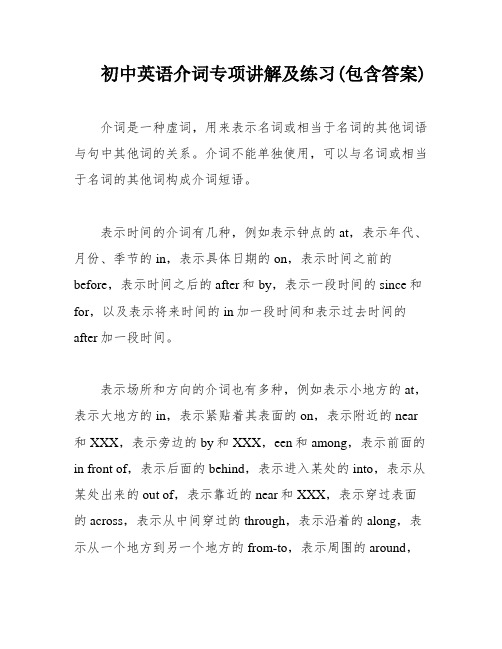
初中英语介词专项讲解及练习(包含答案)介词是一种虚词,用来表示名词或相当于名词的其他词语与句中其他词的关系。
介词不能单独使用,可以与名词或相当于名词的其他词构成介词短语。
表示时间的介词有几种,例如表示钟点的at,表示年代、月份、季节的in,表示具体日期的on,表示时间之前的before,表示时间之后的after和by,表示一段时间的since和for,以及表示将来时间的in加一段时间和表示过去时间的after加一段时间。
表示场所和方向的介词也有多种,例如表示小地方的at,表示大地方的in,表示紧贴着其表面的on,表示附近的near和XXX,表示旁边的by和XXX,een和among,表示前面的in front of,表示后面的behind,表示进入某处的into,表示从某处出来的out of,表示靠近的near和XXX,表示穿过表面的across,表示从中间穿过的through,表示沿着的along,表示从一个地方到另一个地方的from-to,表示周围的around,表示正上方的over,表示正下方的under,表示斜上方的above,表示斜下方的below。
介词的使用需要根据具体情况来判断,掌握介词的用法可以帮助我们更准确地表达自己的意思。
In using a language。
it'XXX to know about the culture and customs of the people you are XXX my experience。
as someone who has lived in different countries。
it's important to adapt and be respectful。
just like you would in your own country.With the right clothing and knowledge。
you can XXX。
初中英语介词练习题&详解
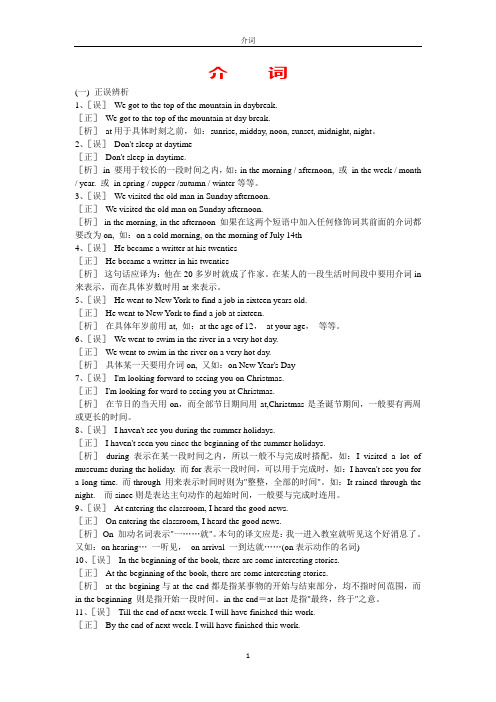
介词(一) 正误辨析1、[误]We got to the top of the mountain in daybreak.[正]We got to the top of the mountain at day break.[析]at用于具体时刻之前,如:sunrise, midday, noon, sunset, midnight, night。
2、[误]Don't sleep at daytime[正]Don't sleep in daytime.[析]in 要用于较长的一段时间之内,如:in the morning / afternoon, 或in the week / month / year. 或in spring / supper /autumn / winter等等。
3、[误]We visited the old man in Sunday afternoon.[正]We visited the old man on Sunday afternoon.[析]in the morning, in the afternoon 如果在这两个短语中加入任何修饰词其前面的介词都要改为on, 如:on a cold morning, on the morning of July 14th4、[误]He became a writter at his twenties[正]He became a writter in his twenties[析]这句话应译为:他在20多岁时就成了作家。
在某人的一段生活时间段中要用介词in 来表示,而在具体岁数时用at来表示。
5、[误]He went to New Y ork to find a job in sixteen years old.[正]He went to New Y ork to find a job at sixteen.[析]在具体年岁前用at, 如:at the age of 12,at your age,等等。
初中英语语法基础——常见介词用法辨析和同步练习题 (有参考答案)

初中英语语法基础——常见介词用法辨析一、“介词”的重要地位:介词是初中的英语的重点,其中一些意思相近的易混淆的介词区分更是需要我们理清楚。
今天就帮你总结一下初中阶段高频出现的一些易混淆的介词用法,让你从此告别看到意思相近介词就一脸懵的囧状。
二、常见介词短语辨析:(1) as, likeas表示“作为”强调身份,like(介词)表示“像”As a teacher, he cares for these children.Like a teacher, he cares for these children.(2) with, inwith表示“外貌特征或附带的东西” ; “用……作工具”in表示“衣着”;“用某语言”,在固定搭配中也可用in。
A man with dark glasses wanted to buy drinks.A man in black wanted to buy drinks.The boy is learning to write in pencil / with a pencil.He retold the text in English.(3) for, tofor表示“为了”;to表示动作对象, “对, 向”He would do anything for his motherland.Did you mention this to my father? 你对我父亲提起过这件事吗?for 表示“就某情况而说”;to 表示一“对某对象而言”It’s quite warm today for February. 就二月的天气,今天够暖和的。
What he told you just now wasn’t new to me. 他刚对你说的话对我并不新鲜。
(4) except, besidesexcept表示“除……之外”,不包括在内, 指从总体中排除一部分;besides表示“除……之外”,包括在内,指除了一部分还有另一部分。
(完整版)初中英语介词用法详解与练习
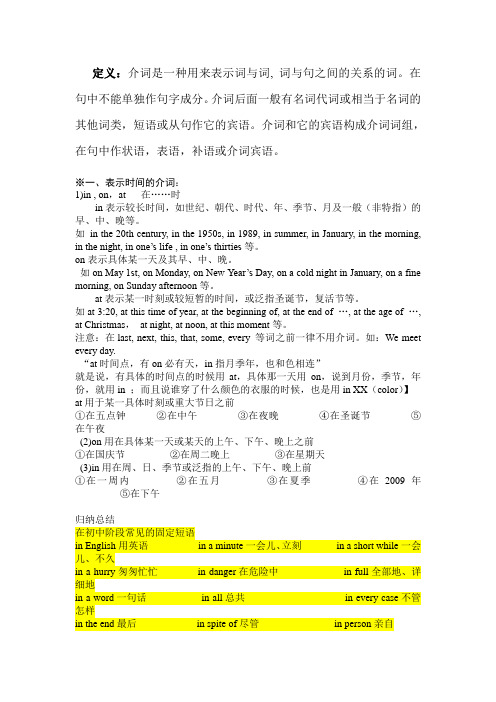
定义:介词是一种用来表示词与词, 词与句之间的关系的词。
在句中不能单独作句字成分。
介词后面一般有名词代词或相当于名词的其他词类,短语或从句作它的宾语。
介词和它的宾语构成介词词组,在句中作状语,表语,补语或介词宾语。
※一、表示时间的介词:1)in , on,at 在……时in表示较长时间,如世纪、朝代、时代、年、季节、月及一般(非特指)的早、中、晚等。
如in the 20th century, in the 1950s, in 1989, in summer, in January, in the morning, in the night, in one’s life , in one’s thirties等。
on表示具体某一天及其早、中、晚。
如on May 1st, on Monday, on New Year’s Day, on a cold night in January, on a fine morning, on Sunday afternoon等。
at表示某一时刻或较短暂的时间,或泛指圣诞节,复活节等。
如at 3:20, at this time of year, at the beginning of, at the end of …, at the age of …, at Christmas,at night, at noon, at this moment等。
注意:在last, next, this, that, some, every 等词之前一律不用介词。
如:We meet every day.“at时间点,有on必有天,in指月季年,也和色相连”就是说,有具体的时间点的时候用at,具体那一天用on,说到月份,季节,年份,就用in ;而且说谁穿了什么颜色的衣服的时候,也是用in XX(color)】at用于某一具体时刻或重大节日之前①在五点钟______②在中午________③在夜晚________④在圣诞节________⑤在午夜_________(2)on用在具体某一天或某天的上午、下午、晚上之前①在国庆节_________②在周二晚上_________③在星期天_________(3)in用在周、日、季节或泛指的上午、下午、晚上前①在一周内_________②在五月_________③在夏季_________④在2009年_________⑤在下午_________归纳总结在初中阶段常见的固定短语in English用英语in a minute一会儿、立刻in a short while一会儿、不久in a hurry匆匆忙忙in danger在危险中in full全部地、详细地in a word一句话in all总共in every case不管怎样in the end最后in spite of尽管in person亲自in fact事实上in good health身体健康的in front of在……前面in some ways在某些方面in common共同的in public当众☆考题再现:---Who was the first man with A(h1n1) flu in mainland China know for sure?---________May 11,2009.A InB OnC ForD Since2、before、afterbefore表示“在某时刻或某件事之前”,after用在时刻或某件事之后。
初中英语七年级方位介词详解及练习

方位介词常用介词in、on、behind、next to、near、over、under等1)(1). in在……里面:It is in the desk.它在课桌里。
(2). on在……上面:It is on the tree.它在树上。
(3). under在……下面/正下方:It is under a basket.他在篮子下面。
(4). over在……正上方:There is a shelf over the table.桌子上方有一个书架。
(5). Between 在……之间It is between two books. 它在两本书之间。
(6). near在……附近:It is near the window. 它在窗户旁。
(7). behind在……之后:It is behind the tree. 它在树的后面。
(8). next to/ beside在……旁边:It is next to/beside an apple. 它挨着苹果。
2)时间或地点介词in、on、at的用法区别:表示时间时, in表示在一段时间里(在将来时句子中则表示在一段时间之后),on表示在具体的某一天或者某天的上下午等,at表示在某个时刻或者瞬间;如:He was born on the morning of May 10th.(他出生于五月十日的早晨)/I usually get up at 7:00 in the morning.(我通常在早上的七点钟起床) /表示地点时, in表示在某个范围之内,on表示在某个平面上或与一个面相接触,at则表示在某个具体的场所或地点。
His glasses are right on his nose.(他的眼镜就架在他的鼻子上)/He is at the cinema at the moment.(此刻他正在电影院)B A B A B AB 在A里——用in A和B相邻(接壤)——用on A和B不相邻(不接壤)——用to。
初中英语《方位介词短语》知识附练习题答案及语法口诀

初中英语《方位介词短语》知识附练习题答案及语法口诀1概念引入本单元学习介词+定冠词the+名词构成介词短语的用法,介词后面可以跟名词和代词做宾语,构成介词短语。
今天我们主要学习一下用来表示方位的介词和介词短语。
2用法讲解1. on介词on表示“在某物之上”的意思,它通常表示一个物体在另一个物体之表面上面。
两者之间有接触。
例如:Your book is on the desk. 你的书在课桌上面。
There is a ball on the floor. 地板上有个球。
拓展:above 和over的区别on指的有接触面的上面,但是over和above都是没有接触面的上面。
over“在……正上方”,与under相对。
例如:There is a bridge over the river. 河上有一座桥。
The picture is hanging over the blackboard.那张图挂在黑板的正上方。
above只表示“在……上方或位置高出……”,不一定是正上方,与below相对。
例如:A plane flew above our heads. 一架飞机从我们头上飞过。
The Turners live above us. 特纳一家人住在我们的上面。
2. in介词in表示“在某物的里面”,它通常表示一个物体在另外一个物体的内部、中间或者在某个范围之内。
例如:Your pen is in the pencil case. 你的钢笔在铅笔盒里面。
She is the tallest in her class. 她是她们班最高的。
3. under介词under表示“在某物的下面”,它通常表示一个物体在另外一个物体的垂直正下面,两者之间没有接触。
例如:My bike is under the tree. 我的自行车在树的下面。
The shoes are under the chair. 鞋在椅子的下面。
初中英语介词解题技巧讲解及练习题(含答案)含解析
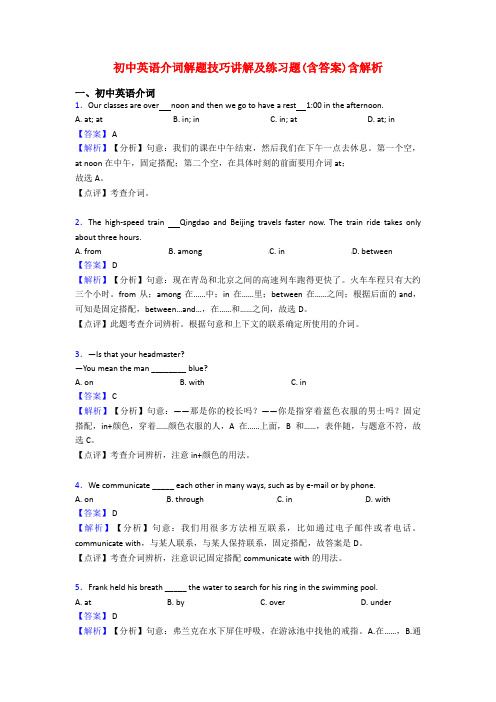
初中英语介词解题技巧讲解及练习题(含答案)含解析一、初中英语介词1.Our classes are over noon and then we go to have a rest 1:00 in the afternoon. A. at; at B. in; in C. in; at D. at; in【答案】 A【解析】【分析】句意:我们的课在中午结束,然后我们在下午一点去休息。
第一个空,at noon在中午,固定搭配;第二个空,在具体时刻的前面要用介词at;故选A。
【点评】考查介词。
2.The high-speed train Qingdao and Beijing travels faster now. The train ride takes only about three hours.A. fromB. amongC. inD. between【答案】 D【解析】【分析】句意:现在青岛和北京之间的高速列车跑得更快了。
火车车程只有大约三个小时。
from 从;among 在……中;in 在……里;between 在……之间;根据后面的and,可知是固定搭配,between…and…,在……和……之间,故选D。
【点评】此题考查介词辨析。
根据句意和上下文的联系确定所使用的介词。
3.—Is that your headmaster?—You mean the man ________ blue?A. onB. withC. in【答案】 C【解析】【分析】句意:——那是你的校长吗?——你是指穿着蓝色衣服的男士吗?固定搭配,in+颜色,穿着……颜色衣服的人,A 在……上面,B 和……,表伴随,与题意不符,故选C。
【点评】考查介词辨析,注意in+颜色的用法。
4.We communicate _____ each other in many ways, such as by e-mail or by phone.A. onB. throughC. inD. with【答案】 D【解析】【分析】句意:我们用很多方法相互联系,比如通过电子邮件或者电话。
【英语】英语介词及其解题技巧及练习题(含答案)含解析

【英语】英语介词及其解题技巧及练习题(含答案)含解析一、初中英语介词1. convenient the way is! We can pay money scanning QR codes(二维码)in many shops.A. How; forB. How; byC. What; by【答案】 B【解析】【分析】句意:这种方式多方便呀!在很多商店,我们可以通过扫二维码付款。
英语中的感叹句强调形容词或副词时用感叹句引导。
How+adj.(adv.)+主语+谓语+(it is)!故使用how.;for介词,为了;by介词,通过某种方式做某事。
此题意思是通过扫二维码的方式付款,表方式用by,故选B。
【点评】此题考查感叹句和介词by用法。
2.Let's take a walk ________ the river after diner, shall we?A. alongB. throughC. uponD. over【答案】 A【解析】【分析】句意:让我们晚饭后沿着河流散步吧,好吗?A.沿着;B.穿过;C.根据;D.在......正上方。
根据常识可知沿着河流散步,along the river,沿着河流,固定搭配,故选A。
【点评】考查介词辨析,注意平时识记其词义,理解句意。
3.I'll be at home __________ Sunday morning. You can phone me then.A. onB. inC. atD. to【答案】 A【解析】【分析】句意:在周日早上我将在家,那时你可以给我打电话。
on+具体时间;in+the+morning/afternoon/evening,在早上/下午/晚上;at+时间点。
Sunday morning指的是周日早上,指的是具体日期,所以用on,故选A。
【点评】考查介词辨析,注意平时识记on、in、at的区别。
4. , I found the job boring, but soon I got used to it.A. To start withB. First of allC. Without doubtD. After all【答案】 A【解析】【分析】句意:起初我觉得工作很无聊,但是我很快就适应了。
(完整版)初中英语语法介词用法讲解与练习
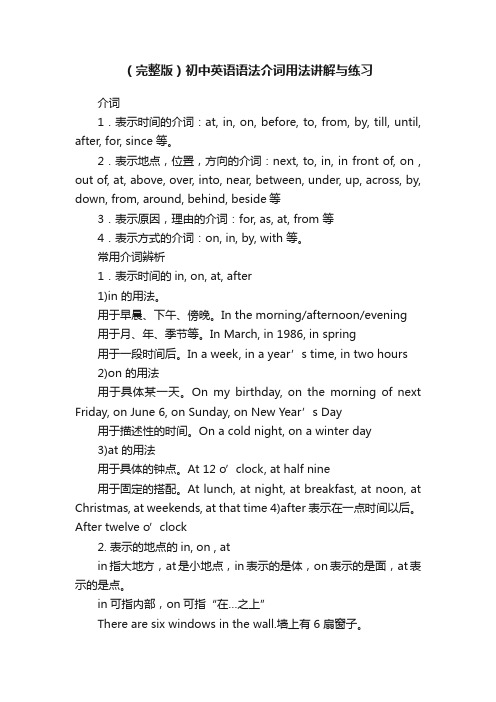
(完整版)初中英语语法介词用法讲解与练习介词1.表示时间的介词:at, in, on, before, to, from, by, till, until, after, for, since 等。
2.表示地点,位置,方向的介词:next, to, in, in front of, on , out of, at, above, over, into, near, between, under, up, across, by, down, from, around, behind, beside等3.表示原因,理由的介词:for, as, at, from 等4.表示方式的介词:on, in, by, with 等。
常用介词辨析1.表示时间的in, on, at, after1)in 的用法。
用于早晨、下午、傍晚。
In the morning/afternoon/evening用于月、年、季节等。
In March, in 1986, in spring用于一段时间后。
In a week, in a year’s time, in two hours2)on 的用法用于具体某一天。
On my birthday, on the morning of next Friday, on June 6, on Sunday, on New Year’s Day用于描述性的时间。
On a cold night, on a winter day3)at 的用法用于具体的钟点。
At 12 o’clock, at half nine用于固定的搭配。
At lunch, at night, at breakfast, at noon, at Christmas, at weekends, at that time 4)after 表示在一点时间以后。
After twelve o’clock2. 表示的地点的in, on , atin指大地方,at是小地点,in表示的是体,on表示的是面,at表示的是点。
初中英语语法练习题系列(附详细答案解析)---介词
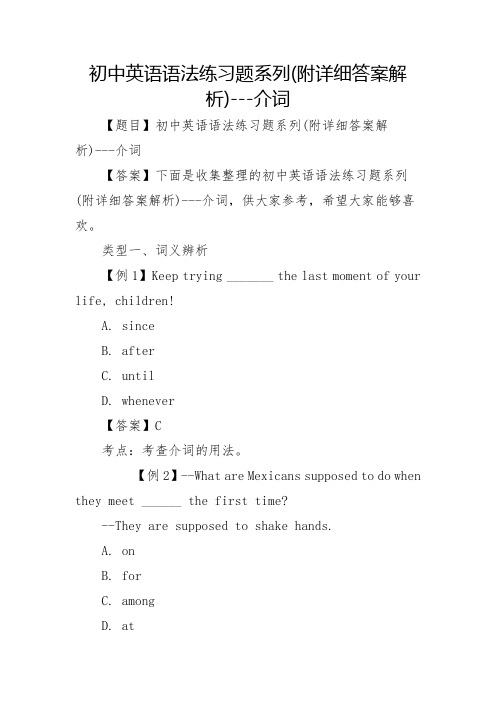
初中英语语法练习题系列(附详细答案解析)---介词【题目】初中英语语法练习题系列(附详细答案解析)---介词【答案】下面是收集整理的初中英语语法练习题系列(附详细答案解析)---介词,供大家参考,希望大家能够喜欢。
类型一、词义辨析【例1】Keep trying _______ the last moment of your life, children!A. sinceB. afterC. untilD. whenever【答案】C考点:考查介词的用法。
【例2】--What are Mexicans supposed to do when they meet ______ the first time?--They are supposed to shake hands.A. onB. forC. amongD. at【答案】B【解析】试题分析:句意:-- 当墨西哥人第一次见面时候,他们应该做什么?--他们应该握手。
分析选项:on在……之上;for对于;among两者之间;at在。
分析:对于第一次见面,因此用介词for.故选B考点:考查介词的用法。
【点睛】词义辨析是介词考查的一个重点,英语中存在着大量的基础介词,如:in、on、at三个介词的区分。
掌握这些介词的用法特点是需要介词的一个关键。
学习中要注意多总结,牢记一些常用介词的词义及用法区别。
类型二、固定搭配【例3】The postcard often reminds me _______ my good friend.A.ofB.forC.atD.with【答案】A【解析】试题分析:句意:这张明信片经常使我想起我的好朋友。
remind sb of sth/sb“使某人想起某事/某人”,故选A。
考点:考查介词的用法。
【点睛】英语介词的一个特点是一词多义,并且介词间语义交叉现象很多,习惯用法也很多,有时很难从词义上区分开来。
故学习中要注意不断总结,熟记一些介词和动词的固定搭配用法及习惯用法,是完成此类问题的捷径。
初中英语介词技巧(很有用)及练习题及解析

初中英语介词技巧(很有用)及练习题及解析一、初中英语介词1.—Excuse me, is there a computer room in your school?—Yes. It's ________ the fifth floor.A. onB. inC. atD. to【答案】A【解析】【分析】句意:——打扰了,你们学校有一个电脑室吗?——是的,在五楼。
on 在......上,in在......里,at指向,to指向。
表示在第几楼使用介词on。
故选A。
【点评】考查常用介词的用法。
2.—Is there ________ in today's morning news on CCTV-1?—Yes, France Team beat Korea Team by 4: 0 in the 8`h FIFA Women's World Cup in France ________ June 8, 2019.A. anything special; onB. something special; inC. special something; onD. anything special; in【答案】 A【解析】【分析】句意:——在央视一今日新闻里有特殊的事情吗?——是的。
法国队在2019年6月8日的法国第八届女子足球世界杯中以4:比0的成绩击败了韩国队。
复合不定代词+形容词,排除B、C。
问句是一般疑问句,所以用anything;on+几月几日,June 8 是几月几日,具体日期,所以用on,故选A。
【点评】考查复合不定代词及介词用法,注意平时识记,理解句意。
3.—Excuse me. Where is the nearest bookstore?—Go ________ Center Street and you'll find it.A. ForB. alongC. with【答案】 B【解析】【分析】句意:——打扰一下。
初中英语语法基础——介词专题讲解 (附同步练习试题)
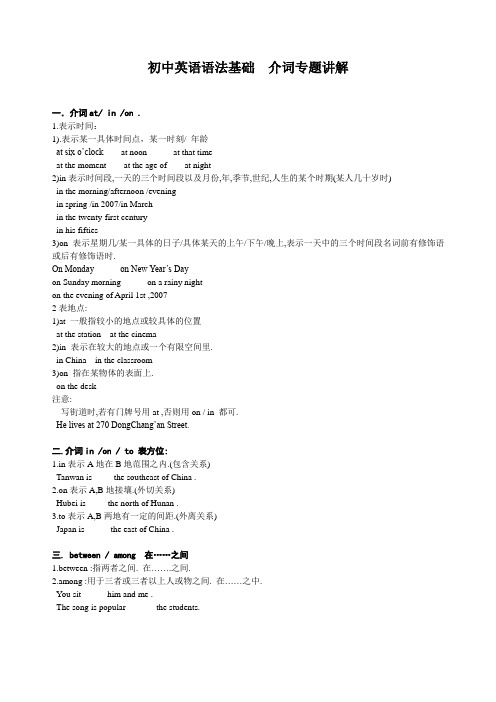
初中英语语法基础介词专题讲解一.介词at/ in /on .1.表示时间:1).表示某一具体时间点,某一时刻/ 年龄at six o’clock at noon at that timeat the moment at the age of at night2)in表示时间段,一天的三个时间段以及月份,年,季节,世纪,人生的某个时期(某人几十岁时)in the morning/afternoon /eveningin spring /in 2007/in Marchin the twenty-first centuryin his fifties3)on表示星期几/某一具体的日子/具体某天的上午/下午/晚上,表示一天中的三个时间段名词前有修饰语或后有修饰语时.On Monday on New Year’s Dayon Sunday morning on a rainy nighton the evening of April 1st ,20072表地点:1)at 一般指较小的地点或较具体的位置at the station at the cinema2)in 表示在较大的地点或一个有限空间里.in China in the classroom3)on 指在某物体的表面上.on the desk注意:写街道时,若有门牌号用at ,否则用on / in 都可.He lives at 270 DongChang’an Street.二.介词in /on / to 表方位:1.in表示A地在B地范围之内.(包含关系)Tanwan is ____ the southeast of China .2.on表示A,B地接壤.(外切关系)Hubei is ____ the north of Hunan .3.to表示A,B两地有一定的间距.(外离关系)Japan is _____ the east of China .三. between / among 在……之间1.between :指两者之间. 在…….之间.2.among :用于三者或三者以上人或物之间. 在……之中.You sit _____ him and me .The song is popular ______ the students.四.after / in 在……之后 before / in 在……之前1. after1)after + 时间段. 表示以过去某一时刻为起点的一段时间之后, 用于过去时.2)after 作介词. after doing sth.2.in +一段时间. 表示说话时或以现在为起点的将来一段时间之后.用于将来时.He came back ______ two days .He will go home___finishing his homework .He will come back _____ two days .3. before 多用于时间点或一件事之前发生,即“先于……;在……之前”He left the office bofore I got there. I’ll be back before five o’clock.4. ago 时间段+ ago 表示“多久之前”时态通常用:一般过去时I met Tom two days ago.五.with / in / by 表示“用……”1.with 表示“用…” 一般指有形的工具/ 手段/ 人体器官.He cut the apple into halves ____ a knife .注: with 表伴随, “带有,含有”He came in _____ a big smile on his face .2.in表示用某种语言,方式,途径. 或书写/绘画所用的材料. 也可表交通方式.Can you say it _____English ?He wrote a letter ____ blue ink .3.by表示乘坐交通工具, 表示方式,方法I study for a test _____ working with a group .He makes a living ____ selling newspapers .注意: 同义词组1).by phone = on the phone2).by car = in a car3).in pen = with a pen = with pens六.across / through / over / by 经过1.across 指横穿,穿过. 表示动作从某一物体表面上经过.2.through 指穿过,透过,表示从某一物体空间内通过.3.over 表示从某人或某物的上空经过或越过,不与表面接触.4.by 表示从某人/某物的旁边经过.Can you swim ______ the river ?the elephant is so big that it can’t go _____ the gate .I don’t think anyone can jump ___ the fenc e.I walked _____ the bank of China yesterday .七.in front of / in the front of1.in the front of 表示在…….内部的前面2.in front of 表示在……外面的前面There is a desk in _____ front of our classroom .There is a big tree in _____ front of our classroom.八.其它介词的用法:1.at的其它用法.1).表示“从事或正在做某事”,其后加的名词往往不加冠词.She is at work now = She is working now .2)at表示“价格或速度”The train ran at 120 kilometers an hour .2.in的其它用法:1)in表示“在……方面”词组:do well in = be good atbe weak in2)in 表示“穿着”后接表颜色的词或衣服.词组: be in +衣服= be wearing +衣服3)in作副词, “在家” = at home3.like 的用法:1).像/和……一样. 常与系动词连用.词组: look like sound like2).与what 连用, “是什么样子, 怎样”.What is he like ? He is kind .4.off的用法:1).从……下来, 脱离某物体.词组: fall off2). “休假”通常放在时间名词之后.词组: have +时间+ offHe has n’t had a night off for two hours .5.except / besides1).except 除了…….之外, 都……. . 不包括在范围之内.注: nothing but … 除了……之外,什么也没有.2).besides除了……之外,还有…… . 包括在范围之内.We all went swimming ______ Lucy .There is _______ a letter in the box .We study Japanese and French____ English .6.with / without1).with具有,含有反义词: without 没有词组: with the help of = with one’s help =because of = thanks towithout one’s help2).without 的用法:A).without + sb./ sth. 没有某人或某物B).without + doing sth . He lef t here without____(say ) “Goodbye”to usC). without sth 常与if 引导的否定的条件句.If there is no water , we can’t live .= We can’t live ______ _______ .7.on the tree /in the treeon the tree 表示“树上本身长的东西” 在树上.in the tree 表示“外界的物体进入树中” 人或物在树上.There are some apples _____ the tree .There is a boy ____ the tree.8.表示“数量的介词”about , round around , over1). about , round around表示“大约……”2).over 表示“超过”= more than.9.inside / outsideInside 在……里面------反义词:outside在….外面10.in the wall /on the wallin the wall 表示“门窗在墙上” on the wall 表示“某东西张贴或挂在墙上”九.不用介词的情况:1).当时间状语为: tonight, today, yesterday, tomorrow 等时,不用介词. What are you going to do tonight ?2).含有this, that, these, those, last, next, every/each day等时间状语.He went to Wuhan last week . I drink milk every day.3).以all 开头的时间状语前面不用介词.He has worked all day .4).以some ,any, one 等构成的时间状语前不用介词.He met a bad man one cold morning. = He met a bad man on a cold morning.介词专题小测:一、单项选择题。
英语介词解题技巧(超强)及练习题(含答案)及解析

英语介词解题技巧(超强)及练习题(含答案)及解析一、初中英语介词1.Don't stay inside such a sunny morning. Let's go out to enjoy the gentle wind and the sweet flowers.A. onB. inC. fromD. at【答案】A【解析】【分析】句意:不要在这样一个阳光明媚的早晨呆在家里。
让我们一起去享受温柔的风和甜蜜的花朵。
A. on 用在某一天,或某一天的早晨,下午、晚上的前面;B. in用在某年,某月,或季节的前面;C. from从,来自;D. at用在表示点钟的时刻前面。
此句中的morning前有形容词sunny来修饰,特指这样的一个上午,前面要用介词on,故选A。
【点评】考查介词辨析。
熟记不同的时间前面的介词用法。
2.The high-speed train Qingdao and Beijing travels faster now. The train ride takes only about three hours.A. fromB. amongC. inD. between【答案】 D【解析】【分析】句意:现在青岛和北京之间的高速列车跑得更快了。
火车车程只有大约三个小时。
from 从;among 在……中;in 在……里;between 在……之间;根据后面的and,可知是固定搭配,between…and…,在……和……之间,故选D。
【点评】此题考查介词辨析。
根据句意和上下文的联系确定所使用的介词。
3.—Thanks to our government, we can have a new library next week.—That's great! And we will read books there ________ a month.A. beforeB. inC. byD. until【答案】 B【解析】【分析】句意:——多亏了政府,下一周我们能够拥有一个新的图书馆。
(完整版)初中介词和介词短语专题讲解(含练习)
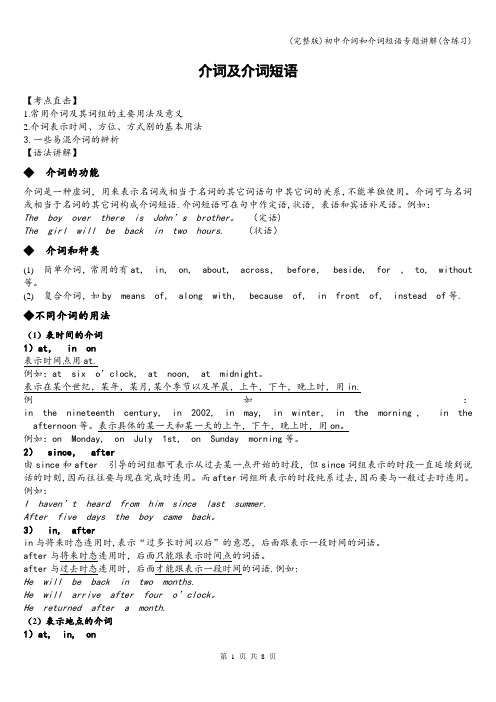
介词及介词短语【考点直击】1.常用介词及其词组的主要用法及意义2.介词表示时间、方位、方式别的基本用法3.一些易混介词的辨析【语法讲解】◆介词的功能介词是一种虚词,用来表示名词或相当于名词的其它词语句中其它词的关系,不能单独使用。
介词可与名词或相当于名词的其它词构成介词短语.介词短语可在句中作定语,状语,表语和宾语补足语。
例如:The boy over there is John’s brother。
(定语)The girl will be back in two hours. (状语)◆介词和种类(1)简单介词,常用的有at, in, on, about, across,before,beside, for , to, without 等。
(2)复合介词,如by means of, along with,because of, in front of, instead of等.◆不同介词的用法(1)表时间的介词1)at,in on表示时间点用at.例如:at six o’clock, at noon, at midnight。
表示在某个世纪,某年,某月,某个季节以及早晨,上午,下午,晚上时,用in.例如:in the nineteenth century, in 2002, in may, in winter, in the morning,in the afternoon等。
表示具体的某一天和某一天的上午,下午,晚上时,用on。
例如:on Monday, on July 1st, on Sunday morning等。
2)since,after由since和after 引导的词组都可表示从过去某一点开始的时段,但since词组表示的时段一直延续到说话的时刻,因而往往要与现在完成时连用。
而after词组所表示的时段纯系过去,因而要与一般过去时连用。
例如:I haven’t heard from him since last summer.After five days the boy came back。
英语介词专题练习(及答案)含解析

英语介词专题练习(及答案)含解析一、初中英语介词1.Stephen Hawking was famous a scientist, he made a great contribution to the world, and he died March 14th, 2018.A. for; onB. as; inC. as; on【答案】 C【解析】【分析】句意:史蒂芬·霍金作为科学家而闻名,他为世界做出了巨大的贡献,他逝世于2018年3月14日。
空一,根据 a scientist ,可知是作为……而出名,be famous as;空二,具体到某一天,使用介词on。
故选C。
【点评】此题考查固定短语和介词用法。
2.My brother joined the army ________ September last year.A. onB. byC. atD. in【答案】 D【解析】【分析】句意:我哥哥去年九月参军。
on后接具体的日期、星期和节日;by后接方式;at后接时间点、时刻;in后接某年某月;September,9月,因此前面用in,故选D。
【点评】此题考查介词。
注意表示年月动名词前用介词in。
3.I'll be at home __________ Sunday morning. You can phone me then.A. onB. inC. atD. to【答案】 A【解析】【分析】句意:在周日早上我将在家,那时你可以给我打电话。
on+具体时间;in+the+morning/afternoon/evening,在早上/下午/晚上;at+时间点。
Sunday morning指的是周日早上,指的是具体日期,所以用on,故选A。
【点评】考查介词辨析,注意平时识记on、in、at的区别。
4.—Shall I help you ________ the street, Grandpa?—No, thanks. I can manage it myself.A. onB. withC. acrossD. along【答案】 C【解析】【分析】句意:——爷爷,我可以帮助你过马路吗?——不用,谢谢。
(英语)中考英语介词的基本方法技巧及练习题及练习题(含答案)
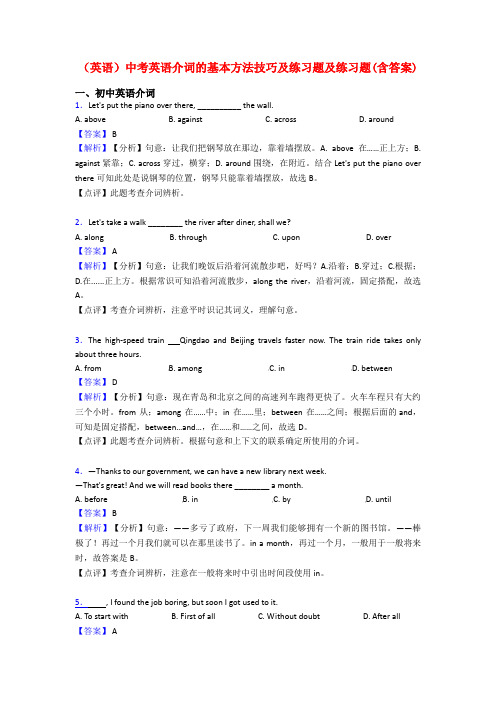
(英语)中考英语介词的基本方法技巧及练习题及练习题(含答案)一、初中英语介词1.Let's put the piano over there, __________ the wall.A. aboveB. againstC. acrossD. around【答案】 B【解析】【分析】句意:让我们把钢琴放在那边,靠着墙摆放。
A. above在……正上方;B. against紧靠;C. across穿过,横穿;D. around围绕,在附近。
结合Let's put the piano over there可知此处是说钢琴的位置,钢琴只能靠着墙摆放,故选B。
【点评】此题考查介词辨析。
2.Let's take a walk ________ the river after diner, shall we?A. alongB. throughC. uponD. over【答案】 A【解析】【分析】句意:让我们晚饭后沿着河流散步吧,好吗?A.沿着;B.穿过;C.根据;D.在......正上方。
根据常识可知沿着河流散步,along the river,沿着河流,固定搭配,故选A。
【点评】考查介词辨析,注意平时识记其词义,理解句意。
3.The high-speed train Qingdao and Beijing travels faster now. The train ride takes only about three hours.A. fromB. amongC. inD. between【答案】 D【解析】【分析】句意:现在青岛和北京之间的高速列车跑得更快了。
火车车程只有大约三个小时。
from 从;among 在……中;in 在……里;between 在……之间;根据后面的and,可知是固定搭配,between…and…,在……和……之间,故选D。
【点评】此题考查介词辨析。
(完整)初中英语介词用法详解与练习.
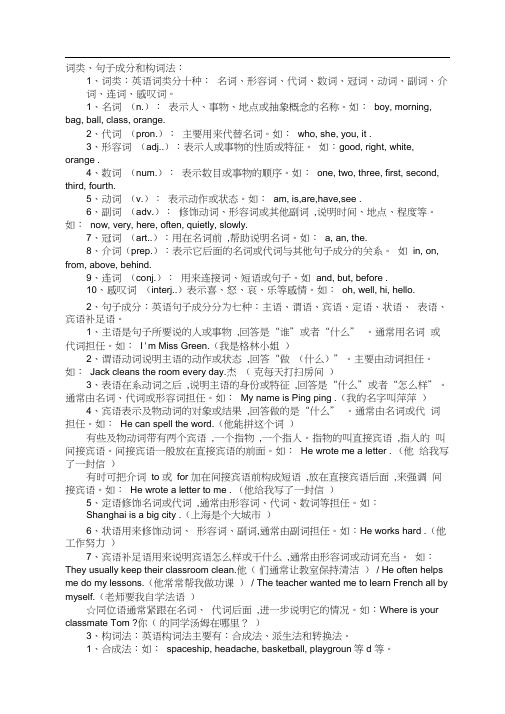
词类、句子成分和构词法:1、词类:英语词类分十种:名词、形容词、代词、数词、冠词、动词、副词、介词、连词、感叹词。
1、名词(n.):表示人、事物、地点或抽象概念的名称。
如:boy, morning, bag, ball, class, orange.2、代词(pron.):主要用来代替名词。
如:who, she, you, it .3、形容词(adj..):表示人或事物的性质或特征。
如:good, right, white, orange .4、数词(num.):表示数目或事物的顺序。
如:one, two, three, first, second, third, fourth.5、动词(v.):表示动作或状态。
如:am, is,are,have,see .6、副词(adv.):修饰动词、形容词或其他副词,说明时间、地点、程度等。
如:now, very, here, often, quietly, slowly.7、冠词(art..):用在名词前,帮助说明名词。
如:a, an, the.8、介词(prep.):表示它后面的名词或代词与其他句子成分的关系。
如in, on, from, above, behind.9、连词(conj.):用来连接词、短语或句子。
如and, but, before .10、感叹词(interj..)表示喜、怒、哀、乐等感情。
如:oh, well, hi, hello.2、句子成分:英语句子成分分为七种:主语、谓语、宾语、定语、状语、表语、宾语补足语。
1、主语是句子所要说的人或事物,回答是“谁”或者“什么” 。
通常用名词或代词担任。
如:I'm Miss Green.(我是格林小姐)2、谓语动词说明主语的动作或状态,回答“做(什么)”。
主要由动词担任。
如:Jack cleans the room every day.杰(克每天打扫房间)3、表语在系动词之后,说明主语的身份或特征,回答是“什么”或者“怎么样”。
【初中英语】 介词专项讲解及练习(1)

必备英语【初中英语】介词专项讲解及练习一、初中英语介词1.—Bill, did you see Tom?—Yes, he just parked his car here and then hurried the street.A. throughB. overC. pastD. across【答案】 D【解析】【分析】句意:—比尔, 你看见汤姆了吗?—是的,他刚刚把车停在这儿,然后匆忙穿过街道。
A. through穿过(从物体中间穿过);B. over越过(在物体上方,不接触);C. past经过(从旁边经过);D. across穿过(从物体表面横穿),穿过街道应该是从表面穿过,用across。
故选D。
【点评】考查介词辨析。
熟记这些介词的含义。
2.I'll be at home __________ Sunday morning. You can phone me then.A. onB. inC. atD. to【答案】 A【解析】【分析】句意:在周日早上我将在家,那时你可以给我打电话。
on+具体时间;in+the+morning/afternoon/evening,在早上/下午/晚上;at+时间点。
Sunday morning指的是周日早上,指的是具体日期,所以用on,故选A。
【点评】考查介词辨析,注意平时识记on、in、at的区别。
3.I will go around the city of Dalian by light-rail vehicle(轻轨) subway because I haven't taken it before.A. instead ofB. in the face ofC. along withD. across from【答案】 A【解析】【分析】句意:我打算不坐地铁,坐轻轨车参观大连,因为我以前从没有坐过。
A.而不是;B.面对;C.和……一起;D.在……对面。
- 1、下载文档前请自行甄别文档内容的完整性,平台不提供额外的编辑、内容补充、找答案等附加服务。
- 2、"仅部分预览"的文档,不可在线预览部分如存在完整性等问题,可反馈申请退款(可完整预览的文档不适用该条件!)。
- 3、如文档侵犯您的权益,请联系客服反馈,我们会尽快为您处理(人工客服工作时间:9:00-18:30)。
初中英语介词讲解与练习题一、表示时间的常用介词表示时间的常用介词有at ,in, after, until, by, before, during.1、at 多用于表示具体的钟点时刻前,所表示的时间大多比较短暂,如:at seven, at a quarter o one; 也可用于固定短语搭配中,如:at noon, at night2、in 表示一段时间,如:年、月、日、世纪、四季或泛指一天的上午、下午、晚上等。
如:in the twenty-first century在21世纪,in autumn 在秋天,in the moring 在早上;还可用于表示“从现在起,多长时间以后或多久以后”的短语。
They will finish the work in an hour. 一个小时以后他们将完成这项工作。
3、on主要用于表示星期几,具体某一天活某一天的早、午、晚或用在节日前。
On Mid-autumn Day 在中秋节,on June 1st 在6月1号4、since,from ,for(1)since 指从某时一直延续至今,后接时间点,主句用完成时。
He has studied English since 2000. 他从2000年久已经开始学英语了。
(2)from 说明开始的时间,谓语可用过去、现在、将来的某种时态。
From now on, I will learn English in the morings. 从今以后我将在早晨学英语。
(3)for指动作延续贯穿整个过程,后接时间段,主句用完成时。
I have studied English for six years. 我已经学6年英语了。
5、(1)after 表示以过去为起点的某一段时间之后,用于过去时。
They finished the work after two years. 他们在两年之后完成了这项工作。
(2)after 与时间点连用表示在将来某个时间之后。
I will ring you up after two o’clock. 两点之后我将给你打电话。
6、“by +时间点”表示“到…为止”,如果by 后加“将来的时间点”应用一般将来时;如果by 后跟一个过去的时间点应用过去完成时。
We had learned 1,000 English words by the end of last year.到上个学期为止,我们已经学了1000个英语单词。
7、“during+时间段”与延续性动词连用表示某期间的动作。
He lives with us during these years. 这些年我们一起住。
8、until用于否定句中,意为“知道…才”,其前的谓语动词多用瞬间性动词;用在肯定句中,意为“知道…为止”,其前的谓语动词须用延续性动词。
I don’t go to bed until my mother came home. 直到我妈妈回家,我才睡觉。
I waited for my mother until she came home. 我等我妈知道她回家为止。
9、before 与after 表示时间,分别意为“在….之前” 和“在…..之后”。
Please bring you r homework before ten o’clock. 请在10点钟之前,带来你的作业。
二、表示地点的介词。
1、in, on , to 的用法。
in 表示在某一地区之内的某方位(属于该范围);to表示在某一地区之外的某方位(不属于该范围);on 表示与某地的毗邻关系。
Taiwan is in the southeast of China. 台湾位于中国的东南部。
(范围之内)Japan is to the east of China. 日本在中国的东边。
(范围之外,不接壤)Korea is on the east of China. 朝向毗邻中国的东边。
(毗邻)2、over,above和on 的用法(1)over指“在….正上方”,表垂直在上。
There is a bridge over the river. 河上有座桥。
(2)above指“在上方”,属于斜上方。
Raise your arms above your head. 把你的胳膊举到头上。
(2)on指“在上面”,表两物体接触。
There is a plate on the table. 桌子上有一个盘子。
3、at, in ,on的区别(1)at 表示较小的地点。
at the bus stop, at home(2)in 表示较大的地点。
in China, in the world(3)on 表示在一个平面上。
On the farm 在农场4、in front of 和in the front of(1)in front of 表式“在…..之前”(范围内)There are some trees in front of the classroom. 教室前面有一些树。
(教室外面的前面)(2)i n the front of表示“在…..的前部”(范围内)Our teacher usually sits in the front of the classroom.我们的老师经常坐在教室的前面。
(教室里面的前面)(3)before 所表示的位置关系和in front of 通用,表示“在……前” “在…..前面”He sits before me. 他坐在我前面。
5、below,underBelow 表示“在下方或位置低于…….”,不一定有垂直在下之意;under表示“在….正下方。
There are many bikes under the tree. 在树下有很多自行车。
The coat reaches below the knees. 这件大衣一直到膝盖先。
三、be made/ used之后介词的选择1、be made 常见结构(1)be made of 在某地制造(2)be made of 和be made from 都可以表示“有…..制成“,但be made of 强调从成品上能看出原材料,而be made from 则表示从成品上看不出原材料。
(3)be made into 被制成……(4) be made after 仿照…..制成(5)be made up of 由…..组成2、be used 常见结构(1)be used to =become used to习惯于(做)……,后接名词,代词或动名词形式。
(2)be used to 被用来做……,后接动词原形(3)be used for 意义相当于be used to do, 但for 后接动名词形式(4)be used as 被当作….来使用(5)be used by 被….. 使用(6)used to 过去常常,后接动词原形。
易混点清单1、in 和on 的区别On the tree 表示枝、叶、果实等长“在树上”In the tree 表示人或其他东西“在树上”。
On the wall 表示东西粘贴或挂“在墙上”。
In the wall 表示门、窗等嵌“在墙上”。
2、between 和among的区别between 常指“在……两者之间”; among指在……(三者或三者以上的人或物)之间”如果把三者以上的人或事物分别看待,指每两者之间,也可用between.Mary sits between Lucy and Lily.Jim stands among his classmates.Y ou shouldn't eat between meals.3、across,through ,over,past的区别Across 和through都用于表示“穿过,越过”。
Across 含有“从……表面穿过”之意。
或指沿某一条线的方向惊醒的动作,表示游渡、乘船过海或过河时用across; through 含有“从…..中间穿过”之意;over 多指在空间范围上“超过”;而past 指经过。
He can swim across the river. 他可以游过这条河。
、She had to push her way through the crowed to get to her son.她必须拨开人群到达她儿子身边。
The plane flew over a line of mountains in the southeast.飞机从东南部的群山上飞过。
They walked past a tall tree. 他们路过一棵大树。
4、in ,with,和by 表示“用”时的区别In主要表示用语言、声音、原材料等,with表示用具体有形的东西;by 表示用…..手段或方式,后常接动名词。
Can you sing this song in English? 你能用英语唱这首歌吗?I write my homework with a pen. 我用一支刚笔写我的作业。
The girl made money by selling flowers. 这个女孩以买花为生。
5、but, besides, 和except 的区别but 表示“除…..之外”,常与含否定意义的词连用,当but 前有动词do 时,but 后接动词原形;except 表示“除…..之外(不再有)”,指从整体中排除except所带的人或物,前面常有all,every,any,no 及其他复合词,但在否定句中,except 却没有排斥性;besides 表示“除…..之外(还有)”,它的意思是在原来的基础上加上besides除外的人或物,其前常有other,another,any other,a few 等词。
We can di nothing but wait. 除了等我们什么也做不了。
All the students go go the zoo except Jim. 除了Jim ,所有的学生都去动物园了。
I have a few good friends besides you. 除了你之外,我还有几个好朋友。
6、at 和to 表行为对象时的区别at 与某些动词连用,表攻击的目标,含有某种程度的恶意;to 只表示方向,无恶意。
Don’t laugh at others. It’s impolite. 不要嘲笑别人,那是不礼貌的。
She came to me and shook my hands warmly. 她向我走来并且热情地跟我握手。
7、of sb.与for sb.的区别(1)of sb.“对于(某人)”,用与It is +adj. +sb. to do sth. 句型中,形容词尾clever,kind,nice等描述人物性格特征的词,of后的人物与形容词有主表关系。
